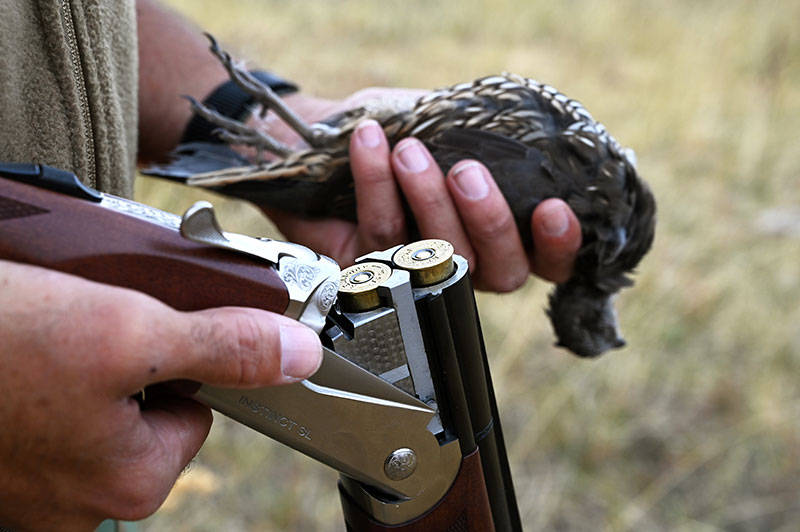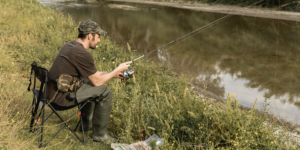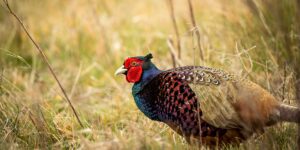What equipment do you need to start hunting roosters?
You’ve studied, you’ve watched all the videos, and now you’re ready to hit the uplands for your first pheasant hunting trip this fall…but not quite yet. Hunting wily roosters and other upland birds is an adventure and requires the right gear to get the job done.
Before you hit your local sportsman’s store, what gear do you need and what can you leave out of your shopping cart? Read on for a list to get you started hunting pheasants this fall.
Why limit yourself to public land when there are millions of acres of private land to explore.
1. Hunting License
Before heading afield, all hunters must have a state hunting license. To purchase a hunting license, individuals must complete a hunter education course. In some states, this must be done in-person, while others allow the course to be taken online. Be sure to plan ahead, as hunter education courses can fill up quickly. You don’t want to miss the start of the hunting season because you’re stuck waiting to get on a course.
2. Shotgun
The most important piece of gear for hunting upland birds is a shotgun. Pheasants are shot on the wing, meaning in the air, so a scattergun is used to get the job done.
Shotguns come in a range of shot sizes, but the most common for pheasant hunting are 12-gauge or 20-gauge. 12-gauge shotguns are definitely the most popular among pheasant hunters. The 12 gauge is the hardest hitting shotgun that gives you the best chance of knocking a bird down. 20 gauge is the second most popular with less recoil than a 12-gauge but also sends less lead downrange. Some hunters even lean towards the unique 16-gauge which falls between a 12- and 20-gauge. A 16 gauge is a nice middle ground to hunt upland birds because it sends more pellets downrange like a 12-gauge, but does not does not have much recoil like a 20-gauge.
Once you have chosen the gauge must also choose which type of shotgun action you prefer. There are many types of actions when it comes to shotguns and those include pump, over/under, side by side, and semi-automatic. Each hunter has their preference when it comes to action type, and each has their own advantages and disadvantages. Example, you only have two shots in an over/under or side by side shotgun, while a pump or semi-automatic shotgun can hold more shells, giving you one or two more pulls of the trigger to bring a flushing bird down.
3. Shotgun Shells
Unlike a bullet that sends one heavy projectile down range, shotgun shells consist of densely packed pellets in a plastic hull. These pellets range in size (shot size), as do the plastic hulls. Shot size ranges numerically, with larger numbers representing smaller shot size. A 12 represents a .05 inch pellet, and The numbering goes up from there through 9, 8½, 8, 7½, 6, 5, 4, 2, with BB being the biggest pellet.
Your shot size decision depends on what type of upland bird species you are pursuing, as well as time of year, and what metal is allowed in the area you are hunting. Obviously hunting quail requires smaller shot than pheasant hunting. Generally, you are allowed to shoot lead shot, but in some areas steel shot is required. Check the regulations carefully.
Shot size varies per species, but you’ll typically see bird hunters using 5 to 7½ size shot.

4. Upland Clothing
When hunting quail and pheasants, you’ll be busting through thick brush, walking in hot or cold conditions, and may even find yourself walking through cattail sloughs and wet grass. For these conditions, it’s best to be outfitted in gear that can handle the elements.
Dedicated upland gear is made to withstand briars and brush, such as upland pants. Upland hunting pants are long pants that feature an extra layer of canvas that lines the front of the leg to keep prickly plants from cutting into the fabric, or pants that are made of a tough, durable material to withstand the abuse from nature (and possibly barbed wire). A good pair of upland hunting pants will allow you to get into the thick stuff that is required when pheasant hunting.
For your upper half, you’ll want to layer up depending on weather conditions. If you’re hunting early-season pheasants, temperatures may still be warm. Look for a lightweight shirt made of a polyester to help wick away moisture. For late-season, especially if you are hunting North or South Dakota, layer with merino wool base layers. Merino helps to not only wick away moisture, but to keep your heat in to keep you warm even in the harshest conditions. Top these off with a game vest and you are good to go.
Tough gloves are an essential piece of hunting gear and are recommended for both cold conditions as well as thick foliage. A sheepskin glove is not only tough, but helps to keep the cold out.
Your upland gear should not only keep you protected against the elements and foliage, but also to protect you from other hunters who may be hunting in your area. It’s important that some, if not all your attire, feature hunters blaze orange. This helps to keep you visible in the field for safety during the fast action. Some states require a certain percentage of blaze orange to be worn. Be sure to check regulations in your state before you hunt.
5. Boots
You’ll be putting a lot of miles on your legs when you hit the field chasing upland game, which means it’s vitally important you outfit your feet with the best boots for the job. Boots that are waterproof are essential, while some may prefer an insulated boot for cold weather hunting. A dedicated lace-up hunting or trekking boot is ideal for upland hunting.
Whatever boots you decide on, it’s essential to break them in long before the season starts. Breaking in a stiff leather boot can cause blisters, and the last thing you want when you hit the field is to have your hunt stopped short because of throbbing blisters on your heel or toes. Take walks around your neighborhood or on a local trail, wear them on everyday activities or even just stroll around your house. Ensuring your boots are well worn before opening day will save you from missing out on any hunting come fall.
6. Bird Vest
An upland hunting vest goes a long way when hunting. It’s an essential piece of equipment that holds most of the necessary gear you’ll need while afield.
A game vest generally consists of two shell pockets that sit at the front of the vest for easy access and a bird pouch that falls at the back to hold your quarry when you bring a bird down. The upland vest also has water bottle pockets to help keep you hydrated, and zippered pockets to carry essentials like extra clothing layers, your cell phone, keys, and hunting license.
Bird vests can be strap vests similar to a backpack where the user has two adjustable shoulder straps and adjustable waist belt, or a vest that is similar to a shooting vest just with extra storage pockets and bird bag.
7. Bird Dog
A dedicated upland hunting dog is not a necessity when hunting pheasants, but it does add to the experience. Watching a gun dog work the fields for birds is a unique sight to see and adds to the fun of the hunt. It also is beneficial to have a dog on the hunt who can help you not only locate live birds, but also downed game that may be hard to see by the human eye in the thick brush.
For your first pheasant hunt, it may be beneficial to locate a friend or mentor who has a dedicated upland dog to show you the ropes before you jump headfirst into purchasing your own four-legged bird hunter pup.
8. Place to Hunt
Utilize mapping systems to locate public land with prime habitat for bird hunting. For private land opportunities, become a member of Wing It for discounted access fees to private land that boast unpressured upland bird coveys.
Check out our article Best states for upland bird hunting for tips on where to hunt (spoiler alert – South Dakota is excellent!) Also, check out our dedicated post on understanding habitat and your options for where to hunt pheasant this season.
9. Gun Safe
Before and after the hunt, it is vitally important that you store your gun in a locked gun safe. Gun safes come in all shapes and sizes and can include biometric locks, keypad locks, or mechanical locks depending on your preference. Make sure to clean your gun before storage, and ensure the gun is unloaded.
10. Cleaning/Cooking Gear
You’ve trekked many miles over upland habitat and brought down a couple of game birds—now the real reward is gained by preparing a delicious game bird dinner. A dedicated hunting knife is great for cleaning your quarry, and a cooler filled with ice in the back of your truck can help keep your birds cool before you clean them if you aren’t done hunting yet. Heat can spoil your hard earned work, be sure to clean and care for your game birds so that the meat doesn’t spoil before you can cook and enjoy it. You might also want to throw in some canned food as a back up, and don’t forget a knife and fork for eating with.
Check the weather before you head out and remember to pack enough water for yourself and the dogs for the conditions.
11. Survival/ first aid kit
If you’re heading off into the wilds there are a few essential items you need to carry with you. A basic first-aid kit is a must (though obviously if you are in a group you don’t need to carry one each). Duct tape is always handy for repairs, and consider carrying extra batteries for anything that needs them. Needle nose pliers are useful or a decent multi tool that will cover many bases. Don’t forget jumper cables for your vehicle as you’ll be in wild places.
12. Hunting trip partners
If you’re looking for some peace and quiet, and want to head off on your own, that’s totally fine. If not, you’ll probably find starting much easier, and enjoyable, with some hunting partners. Joining forces with seasoned hunters is a great way to learn. They’ll have all the gear, they can give you the low down on the local terrain and they’ll probably have dogs too. They’ll give you somebody to discuss the latest articles and tips, you can share the weight of the gear and you may get some laughs along the way.
If you are alone, and heading somewhere remote, don’t forget to leave your whereabouts and next of kin contact info with a friend or neighbor. Better safe than sorry…
As you become a more advanced upland hunter, you may find more essential gear to add to this list, such as a game bag and a lightweight pair of shooting glasses, but for now these 12 items are what you need to get started pheasant hunting. Hit your nearest sporting store and fill your shopping cart—that’s just part of the adventure of upland hunting.
Why limit yourself to public land when there are millions of acres of private land to explore.



